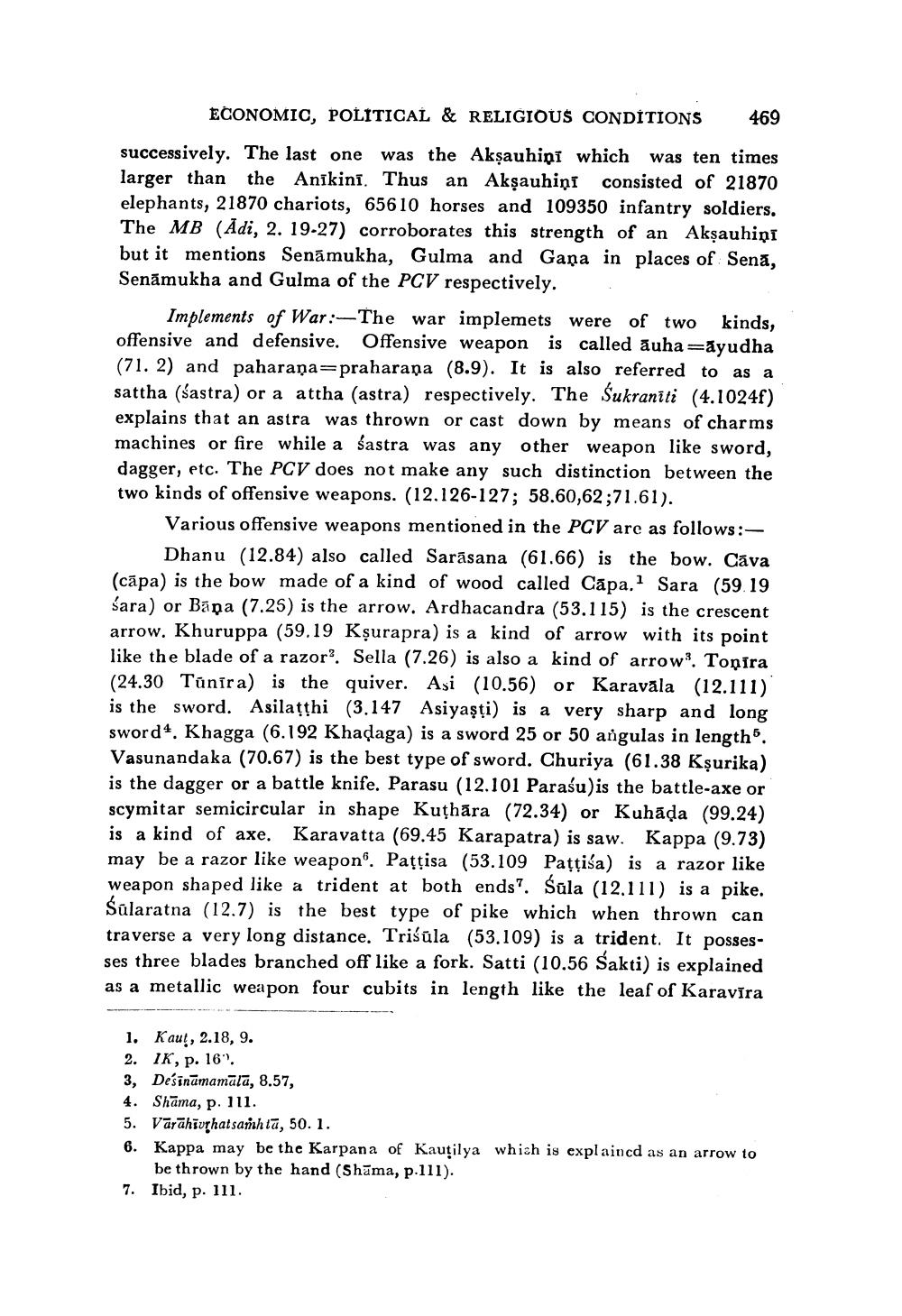________________
ECONOMIC, POLITICAL & RELIGIOUS CONDITIONS
469
successively. The last one was the Akṣauhiņī which I was ten times larger than the Anikini. Thus an Akṣauhiņi consisted of 21870 elephants, 21870 chariots, 65610 horses and 109350 infantry soldiers. The MB (Adi, 2. 19-27) corroborates this strength of an Akṣauhiņi but it mentions Senāmukha, Gulma and Gana in places of Senā, Senāmukha and Gulma of the PCV respectively.
Implements of War:-The war implemets were of two kinds, offensive and defensive. Offensive weapon is called auha=ayudha (71. 2) and paharana=praharana (8.9). It is also referred to as a sattha (sastra) or a attha (astra) respectively. The Sukraniti (4.1024f) explains that an astra was thrown or cast down by means of charms machines or fire while a sastra was any other weapon like sword, dagger, etc. The PCV does not make any such distinction between the two kinds of offensive weapons. (12.126-127; 58.60,62;71.61).
Various offensive weapons mentioned in the PCV are as follows:
Dhanu (12.84) also called Sarasana (61.66) is the bow. Cava (capa) is the bow made of a kind of wood called Capa.1 Sara (59.19 sara) or Bana (7.25) is the arrow. Ardhacandra (53.115) is the crescent arrow. Khuruppa (59.19 Kṣurapra) is a kind of arrow with its point like the blade of a razor3. Sella (7.26) is also a kind of arrow3. Toņira (24.30 Túnira) is the quiver. Asi (10.56) or Karavala (12.111) is the sword. Asilatthi (3.147 Asiyaşți) is a very sharp and long sword. Khagga (6.192 Khadaga) is a sword 25 or 50 angulas in length". Vasunandaka (70.67) is the best type of sword. Churiya (61.38 Kşurika) is the dagger or a battle knife. Parasu (12.101 Paraśu) is the battle-axe or scymitar semicircular in shape Kuṭhāra (72.34) or Kuhada (99.24) is a kind of axe. Karavatta (69.45 Karapatra) is saw. Kappa (9.73) may be a razor like weapon". Pattisa (53.109 Pattiśa) is a razor like weapon shaped like a trident at both ends. Sula (12.111) is a pike. Súlaratna (12.7) is the best type of pike which when thrown can traverse a very long distance. Triśula (53.109) is a trident. It possesses three blades branched off like a fork. Satti (10.56 Śakti) is explained as a metallic weapon four cubits in length like the leaf of Karavīra
1. Kaut, 2.18, 9.
2. IK, p. 16".
3, Desinamamala, 8.57,
4. Shama, p. 111.
5. Varahivṛhatsaṁhtu, 50. 1.
6. Kappa may be the Karpana of Kautilya which is explained as an arrow to be thrown by the hand (Shama, p.111).
7. Ibid, p. 111.




